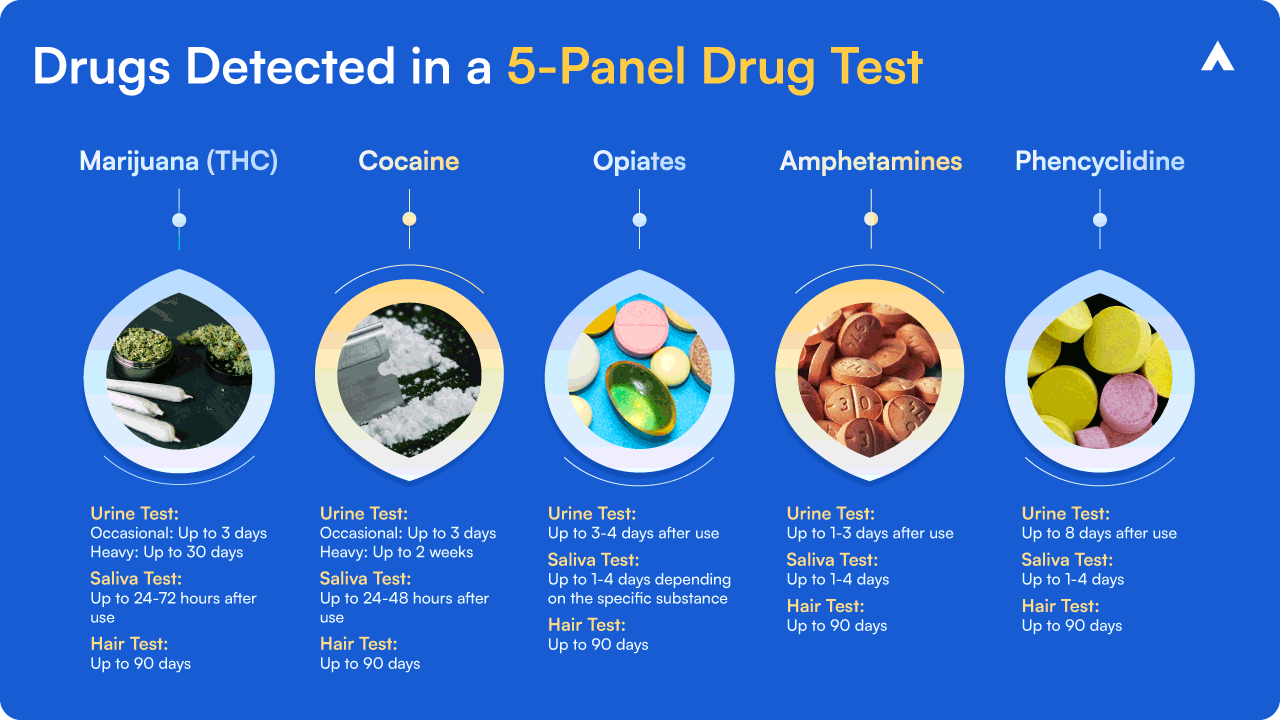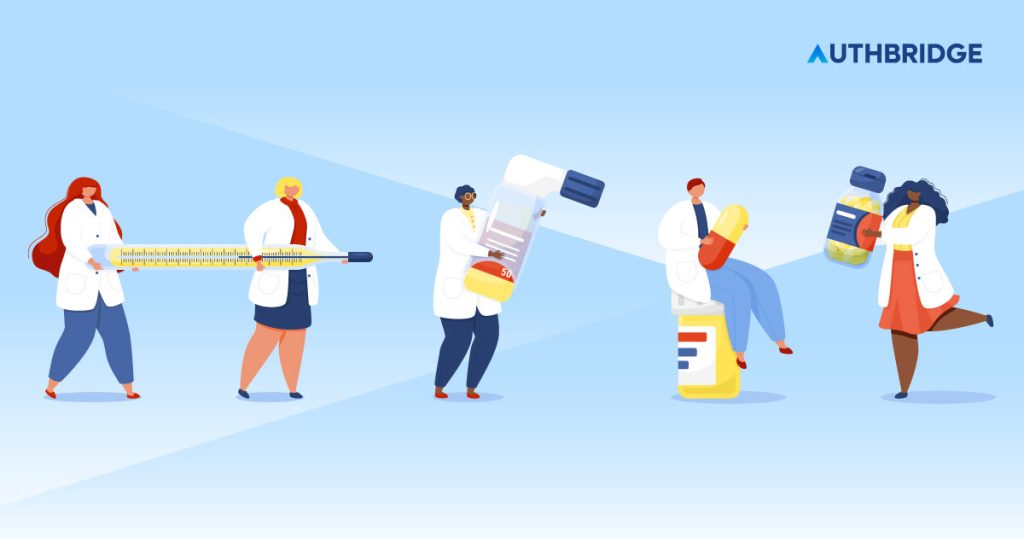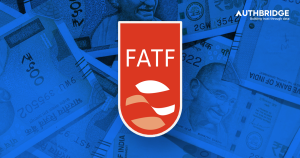Have you ever wondered what happens behind the scenes when you apply for a new job? Beyond the resume and interview and the BGV, there’s often a crucial step: the drug test. However, with different panels and variations, exploring the world of workplace drug screening can be confusing. In this blog, we’ll delve into the importance of 5-panel drug tests, revealing what they check for, why they matter, and how to choose the right test for your needs.
What Is A 5-Panel Drug Test?
A 5-panel drug test is a widely-used screening method designed to detect the presence of five specific drugs in an individual’s system. The drugs tested for in the 5-panel drug test are marijuana (THC), cocaine, opiates (heroin, morphine, and codeine), amphetamines (including methamphetamine), and phencyclidine (PCP). The test is popular due to its simplicity, cost-effectiveness, and the broad range of commonly abused substances it can detect.
The test can be administered through various biological samples, such as urine, saliva, and hair. The choice of sample depends on the specific requirements of the testing context, whether it’s for pre-employment screening, legal purposes, or personal monitoring.
History And Purpose of 5-Panel Drug Testing
The history of the 5-panel drug test dates back to the late 1980s when the U.S. Department of Transportation (DOT) introduced it as a standard for federally mandated drug testing programs. The main purpose of this test is to promote safety, particularly in industries where employees operate heavy machinery, drive vehicles, or perform safety-sensitive tasks.
The 5-panel drug test has since become a standard due to its effectiveness in detecting commonly abused substances. It is widely used by employers for various reasons. The test helps ensure a drug-free environment, enhances safety, and promotes health and wellness by identifying and addressing substance abuse issues early.
In contrast, 5-panel drug tests are rarely employed in highly regulated sectors such as law enforcement, healthcare, or government. These industries often require more comprehensive drug screenings to meet stringent regulatory requirements.
Substances Detected In A 5-Panel Drug Test


1. Marijuana (THC)
Marijuana, also known as cannabis, is the most commonly used illicit drug. THC (tetrahydrocannabinol) is the primary psychoactive component of marijuana. The detection time for THC can vary based on the frequency and quantity of use, the individual’s metabolism, and the type of test used.
- Urine Test: Detects THC for up to 3 days in occasional users and up to 30 days in heavy users.
- Saliva Test: Detects THC for up to 24-72 hours.
- Hair Test: Can detect THC for up to 90 days.
2. Cocaine
Cocaine is a powerful stimulant derived from the coca plant. It is highly addictive and can be detected in various biological samples.
- Urine Test: Detects cocaine for up to 3 days after use.
- Saliva Test: Detects cocaine for up to 24-48 hours.
- Hair Test: Can detect cocaine for up to 90 days.
3. Opiates
Opiates, including heroin, morphine, and codeine, are narcotic drugs derived from the opium poppy plant. They are used medically for pain relief but are also commonly abused.
- Urine Test: Detects opiates for up to 3-4 days after use.
- Saliva Test: Detects opiates for up to 1-4 days.
- Hair Test: Can detect opiates for up to 90 days.
4. Amphetamines
Amphetamines, including methamphetamine, are stimulants that affect the central nervous system. They are prescribed for conditions like ADHD but are often abused for their energising effects.
- Urine Test: Detects amphetamines for up to 1-3 days after use.
- Saliva Test: Detects amphetamines for up to 1-4 days.
- Hair Test: Can detect amphetamines for up to 90 days.
5. Phencyclidine (PCP)
PCP, also known as angel dust, is a dissociative drug that can cause hallucinations and neurotoxicity.
- Urine Test: Detects PCP for up to 8 days after use.
- Saliva Test: Detects PCP for up to 1-3 days.
- Hair Test: Can detect PCP for up to 90 days.
Different Types Of 5-Panel Drug Tests: Urine, Saliva & More
1. Urine Drug Test
The urine drug test is the most common method for administering a 5-panel drug test. It is non-invasive, cost-effective, and provides reliable results. The process involves collecting a urine sample in a sterile container, which is then sent to a laboratory for analysis.
- Detection Window: Generally up to a few days after drug use.
- Procedure: The sample is tested using immunoassay screening, and any positive results are confirmed with gas chromatography-mass spectrometry (GC-MS).
2. Saliva Drug Test
Saliva drug tests are less invasive than urine tests and provide quicker results. They are often used for on-the-spot testing in workplace or roadside testing scenarios.
- Detection Window: Typically up to 24-48 hours after drug use.
- Procedure: A swab is used to collect saliva from the inside of the mouth, and the sample is analysed for drug metabolites.
3. Hair Follicle Drug Test
Hair follicle tests can detect drug use over a longer period, making them useful for identifying chronic drug use. This type of test involves taking a small sample of hair, usually from the head, for analysis.
- Detection Window: Up to 90 days or longer, depending on hair length.
- Procedure: If needed, the hair sample is tested using an enzyme-linked immunosorbent assay (ELISA) and confirmed with GC-MS.
How To Administer A 5-Panel Drug Test?
1. Collection Process
The collection process for a 5-panel drug test varies based on the type of test. For urine tests, the individual provides a urine sample in a sterile container. Saliva tests involve swabbing the inside of the mouth, while hair tests require a small sample of hair, usually from the scalp.
2. Laboratory Analysis
Samples are sent to a certified laboratory where they undergo initial screening and confirmation testing if needed. The screening process typically involves immunoassay techniques, while confirmation testing uses more specific methods like gas chromatography-mass spectrometry (GC-MS).
- Urine Tests: Typically involve an immunoassay screening followed by GC-MS for confirmation.
- Saliva Tests: Use enzyme immunoassay (EIA) for screening and confirmatory tests with GC-MS.
- Hair Tests: Initially tested with ELISA, confirmed by GC-MS.
3. Results Interpretation
Results are interpreted by comparing the concentration of drugs in the sample to established cutoff levels. A positive result indicates the presence of drugs above the threshold, while a negative result means no drugs were detected or levels were below the cutoff.
- Positive Results: Indicate the presence of drugs and may require a confirmation test.
- Negative Results: Indicate no drugs were detected or levels are below the detectable limit.
Importance Of 5-Panel Drug Testing In the Workplace
1. Employment Screening
Many employers use 5-panel drug tests as part of their pre-employment screening process to ensure a drug-free workplace. This helps maintain safety, productivity, and compliance with industry regulations. Industries like transportation, healthcare, and construction commonly require pre-employment drug screening.
2. Legal and Criminal Justice
5-panel drug tests are used in legal and criminal justice settings to monitor compliance with drug-related laws and rehabilitation programs. They help ensure individuals adhere to court-mandated sobriety. Courts may require individuals on probation to pass regular drug tests to avoid incarceration.
3. Personal Testing
Individuals may choose to undergo 5-panel drug testing for personal reasons, such as monitoring their substance use or ensuring compliance with treatment programs. This can be a proactive step towards recovery and maintaining sobriety.
Advantages & Limitations Of 5-Panel Drug Tests
The main advantages of 5-panel drug tests include their cost-effectiveness, ease of administration, and ability to detect commonly abused substances. They provide reliable results that are widely accepted in various settings.
- Cost-Effectiveness: 5-panel tests are affordable and widely available.
- Ease of Administration: Simple collection process and quick results.
- Reliability: High accuracy and acceptance in legal and employment contexts.
Potential Limitations And Controversies
Despite their advantages, 5-panel drug tests have limitations. They do not detect all possible drugs of abuse, and false positives can occur. There are also privacy concerns and potential discrimination based on test results.
- Detection Limitations: Some newer synthetic drugs may not be detected.
- False Positives: Certain medications and foods can trigger false positives.
- Privacy Concerns: The need for sample collection can raise privacy issues.
- Discrimination: Test results can potentially be used to discriminate against individuals.
Legal And Regulatory Aspects Of Drug Testing In India
Workplace Regulations
In India, workplace drug testing is subject to regulations that ensure the rights of employees are protected while maintaining a drug-free environment. Employers must adhere to legal standards when implementing drug testing policies.
- Guidelines: The Ministry of Labour and Employment provides guidelines for drug testing in the workplace.
- Compliance: Companies must follow proper procedures to ensure compliance with these guidelines.
Legal Standards
Legal standards for drug testing in India vary by jurisdiction but generally aim to balance public safety with individual rights. Compliance with these standards is crucial for the validity of the testing process.
- Statutes: Various labour laws and regulations govern workplace drug testing.
- Employee Rights: Employees have the right to privacy and fair treatment during the testing process.
5-panel Drug Tests: Frequently Asked Questions
The most common form of drug test is the urine drug test. This method is widely used due to its cost-effectiveness, non-invasiveness, and the relatively long detection window for many substances.
A 5-panel drug test is a commonly used test that screens for marijuana, cocaine, opiates, amphetamines, and phencyclidine (PCP).
A 5-panel urine drug test typically detects drug use within the past few days to a month, depending on the substance and frequency of use. For example, marijuana can be detected for up to 30 days, while cocaine and opiates are usually detectable for 2-4 days.
A urine drug test can detect various substances, with the specific number depending on the panel used. A 5-panel test typically screens for marijuana (THC), cocaine, opiates (e.g., heroin, morphine, codeine), amphetamines (e.g., methamphetamine), and phencyclidine (PCP).
A positive drug test indicates that the tested individual has detectable levels of one or more illegal or controlled substances in their system. This result means the person has recently used the drugs included in the test panel. Positive results typically lead to further confirmatory testing to rule out false positives and ensure accuracy.






